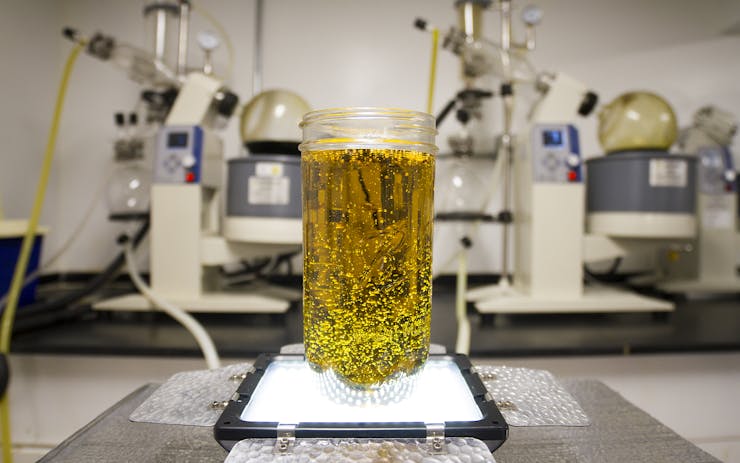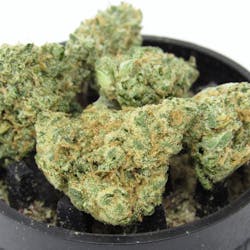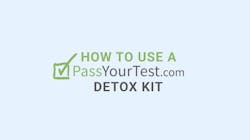With the extract market burgeoning, there’s an increased focus on how those products are produced. Solvent extraction methods have advanced quickly over the past few years, with popular solvents including ethanol, CO2, and hydrocarbons—organic compounds containing only hydrogen and carbon atoms—which in cannabis are usually butane and propane. If you’ve used vape oil, edibles, or any number of products that incorporate extracts, you could well have been sampling the fruit of hydrocarbon extraction.
While they don’t sound like compounds you want to be ingesting, hydrocarbons have been used in food extraction for over five decades, for example, in the production of flavors and colorings. More recently, compounds like butane and propane are used to produce cannabis extracts with specific profiles. The purity and potency of hydrocarbon extracts vary greatly, but you can find THC-rich extracts that contain up to 90% of the plant’s original cannabinoids.
If carried out correctly, hydrocarbon extracts can be safe, both in terms of minimizing production risks and creating a product fit for consumption. Here we’ll talk about the details of hydrocarbon extraction processes, including their benefits and drawbacks, and we’ll also discuss which products are manufactured in this manner.
Cannabis products made using hydrocarbon extraction
Hydrocarbon extracts can come in a variety of forms, including oil, glass, shatter, wax, and hash. These extracts are sometimes synonymous with Butane Hash Oil (BHO), which is often heated and inhaled in a process known as dabbing. That said, hydrocarbon extracts can be used in many other types of products, including edibles, vape cartridges, capsules, and topicals (including transdermal patches).
For extracts to be of high quality, you still need to start with a quality product. For example, nug runs—concentrates that use cannabis flower—are considered of higher quality than trim runs. Plus, the extraction process used, including any refinement steps, will determine the profile and quality of the final product.
What is hydrocarbon extraction?
Hydrocarbon extraction usually involves butane as the primary solvent, although other hydrocarbons or a blend of two or more may be used. When combined with cannabis plant material, the hydrocarbon dissolves desirable compounds present in the plants.
Butane is an ideal solvent for cannabis extraction—it has a low boiling point of 30.2°F (-1°C) and is used in extraction as a liquified gas. This allows you to avoid exposing temperature-sensitive terpenes and other delicate components to heat.
The boiling point of propane is even lower than that of butane at -43.6°F (-42°C). It’s common to see a blend of both used. Propane may provide benefits by stripping additional desirable compounds, such as terpenes, from the plant. It also allows for a more effective purging of leftover solvent.
Shop highly rated dispensaries near you
Showing you dispensaries nearHere are the general steps for hydrocarbon extraction:
- Cold, liquified butane (or hydrocarbon blend) is used to wash the plant matter, dissolving cannabinoids (such as THC and CBD) and terpenes (which provide aroma and flavor), often along with lipids and waxes.
- The resulting solution may then be refined using a number of methods, depending on the final product. For example, centrifugation can be used to remove terpenes and winterization can remove lipids from the concentrate. Dewaxing and decarboxylation are other common refinement steps.
- After refinement, the resulting solution is passed through a collection chamber to remove the majority of the residual solvent. The butane is often transported back to the start of the process to be reused.
Finally, the concentrated solution is further purged to get rid of any excess hydrocarbons. The process will depend on the final product but may involve drying in a vacuum oven or whipping.
While hydrocarbon extractions can technically be carried out anywhere, the dangers of dealing with butane gas can often produce disastrous results. Producers of legal extracts work in compliant environments and use equipment specially designed for this application. Do not try this at home.
The benefits and drawbacks of hydrocarbon extraction
Hydrocarbon extraction isn’t the only technique out there, and other extraction processes may be preferable depending on the desired outcome. Here are the main pros and cons of hydrocarbon extraction:
Benefits
You can maintain the authenticity of the strain. Each strain has a unique chemical profile which other extraction methods can render unrecognizable. Hydrocarbon extraction can maintain the delicate makeup of the plant so that the original combination of cannabinoids and terpenes remains in the final product.
It offers versatility. There is a range of extract types that can be produced using hydrocarbon extraction because the levels of butane and propane can be tweaked to create the desired profile. Depending on the strain and how involved the production method is, you’ll find products at a broad range of price points.
You can use up trim. Due to the nature of hydrocarbon extraction, you can make use of the less desirable parts of the plant. For example, trim from cannabis harvests might otherwise be discarded as waste. However, these loose leaves still bear lots of resin that is rich in cannabinoids. These and other components can be extracted using hydrocarbon extraction, producing products known as trim runs.
Drawbacks
Extractions can pose risks. If not carried out properly, hydrocarbon extraction methods can be very dangerous. Butane and propane are highly flammable so the equipment and environment must meet strict standards before being considered safe.
It’s possible to produce hazardous products. Similarly, if hydrocarbon extraction is not conducted properly, the consumer could be at risk. For example, some amateur products will use low-quality solvents that contain unknown contaminants. They might also fail to purge the final product of solvents at the end of the extraction, and sell items with residual solvent levels far above what is considered safe. This is one of the reasons it’s important to only purchase lab-tested products, so you know exactly what you’re getting.





